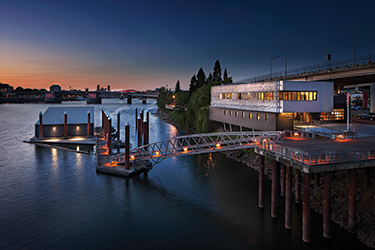|
Subscribe / Renew |
|
|
Contact Us |
|
| ► Subscribe to our Free Weekly Newsletter | |
| home | Welcome, sign in or click here to subscribe. | login |
Construction
| |
 |
November 5, 2015
How to keep fire crews moving as the city grows
TCA Architecture Planning

Harris
|
At its simplest level, a fire station is a sophisticated “cog in the wheel” that programmatically supports emergency operations with the continually evolving task of defining what there is to protect and how best to do it.
Over the last 25 years, the Puget Sound area has seen significant changes in the design of fire stations as older facilities have been remodeled and replaced.
As technology and the workforce have changed, fire station designs have also responded to these new circumstances. Terms that have become commonplace include urban responsibility, neighborhood oriented, seismically resilient, gender inclusive, energy use index and sustainable.
The Puget Sound area has been a leader in redefining next-generation facilities. Not only does the area boast the first LEED-certified fire station in the country (city of Issaquah, 2003), it also is home to the first LEED platinum fire station (city of Issaquah, 2011) and the first LEED training facility in the country (city of Seattle, 2009).
These facilities have pushed the envelope of what an emergency facility can become from a sustainability perspective. As a result, these facilities have provided insight to other communities around the country: the city of Portland recently completed a LEED gold waterfront fire facility with input from our area, and Salt Lake City has two net-zero fire stations in design that take guidance from local projects as well.
As we fine-tune the lessons learned from stations built over the last decade, a significant fire station design consideration will gain new attention as a direct result of our explosive regional growth.
Growth means more people, more congestion, and an increase in emergency and nonemergency calls. If not addressed, response times will increase and eventually impact service levels.
Turnout time
While effectively tackling increased call load may require additional funding for staffing and apparatus (impacting facility needs), it also requires leveraging existing resources effectively. Understanding changing density, traffic patterns and demographics through sophisticated GIS modeling and real time and projected traffic data will help determine areas of increased demand.
Since staffing, equipment and facilities come at a significant cost, we are seeing “turnout time” getting significant attention. Turnout time can be defined as when the emergency response facility and the emergency response unit’s notification process begins by either an audible or visual annunciation (or both) and ends at the beginning point of travel time. It’s the “call receipt at the station to wheels rolling.”
National Fire Protection Association Standards stress speed of response with specific time lines for fire versus emergency medical response calls. Depending on the type of call, turnout time within a facility accounts for approximately 20 percent of the targeted time after call receipt within a facility to arrival on scene.
Cutting seconds off a call within a facility can help offset this increased demand as our community continues to grow.
Snohomish County Fire District 1, protecting nearly 200,000 citizens in 45.6 square miles, is tackling this issue head on. The district will soon start a study to evaluate the impact of growth in its service area relative to response, as well as turnout times within all of its stations. Taking an inside-out/outside-in approach, the district will be able to understand the most effective way to address this emerging issue.
What contributes to reducing turnout time within a facility?
A 2009 study of several departments — including Puget Sound’s Eastside Fire & Rescue — by Michael Dell’Orfano of South Metro Fire Rescue Authority found behavioral factors such as motivation, station call load, daytime versus nighttime response and station familiarity have an impact on turnout time. Additionally, technical factors such as data transfer, travel distance, clear paths of travel, support space location and bay door speed impacted turnout time.
Both behavioral and technical aspects affect the ability of an organization to have a positive impact on the outcome of an emergency based on how quickly appropriate resources are deployed to an event.
An underlying philosophy in fire station design is to provide direct and unobstructed paths of travel to the apparatus being deployed such that all paths of travel flow efficiently with minimal turns towards the bays. Generally the closer to the apparatus is to the responder the quicker the turnout time.
Firefighter health
As regional response continues to be addressed for the sake of saving lives and protecting property, increased attention is also being placed on the health and safety of the responders that provide this service.
Recently the National Institute for Occupational Safety, with funding from the U.S. Fire Administration, undertook a detailed study of almost 20,000 firefighters to understand cancer rates in the profession. Findings suggest that firefighters are at a higher risk of cancers of the digestive, oral, respiratory and urinary systems compared to the general population due to job-related exposure.
A recent Firehouse magazine article notes, “while scientific studies connecting what firefighters do with their health consequences is still in their infancy, common-sense observations and actions can be made about exposure to carcinogens, transport of the cancer-causing agents back to the fire station and control measures to limit their impact.”
As this and like studies continue to gain attention, we are increasingly seeing departments take a stronger and more proactive position to understand and better mitigate exposure to cancer-causing agents both outside and inside the fire station.
Previously, facility testing has not been common due to cost, however we are seeing more interest in doing such testing to better understand risk. Additionally, there has been increased sensitivity to clearly identify “hot zones” within the facility, where potentially carcinogen-contaminated equipment is transported back to a facility from a call and stored, decontamination and cleaning occurs, potentially contaminated turnout gear is hung and apparatus is parked.
In addition to carcinogens, this same equipment can carry contagious bacteria that also pose a risk to responders.
Ironically, current codes that focus on energy conservation (allowing for decreased ventilation) are becoming increasingly at odds with typical air capture, dilution and filtration strategies. This will be the next nut to crack. As a starting point, better definition of transition areas between high- and low-hazard areas within stations will be a big step forward.
As new facilities are designed and renovated, fire stations will continue to become more specialized relative to performance from both response and safety perspectives. Both the fire service and design community will need to continue to shift their mindset in terms of performance-based ends rather than means through better definition of objectives, data gathering, modeling, evaluation and measuring results.
Brian Harris is a principal with TCA Architecture Planning and has specialized in fire facility design for over 25 years. TCA has been involved with the planning of more than 250 fire facilities nationwide.
Other Stories:
- Will your fire station be open after the Big One hits?
- Here’s how we slashed one station’s energy use by 75 percent
- Fire Training centers today are more like the real world
- Interbay fire station is one of the nation’s greenest



